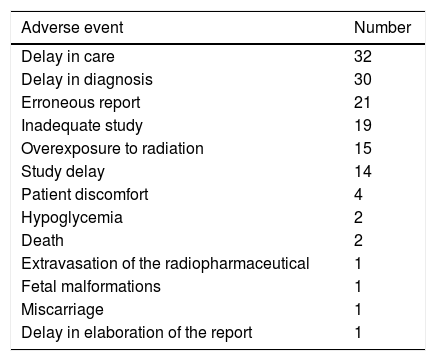Patient safety is an essential component of quality of care, especially when the complexity of care has reached extreme levels. Currently achieving this safety is considered a basic strategy of the National Health System. Nuclear Medicine departments have certain peculiarities that make them special in terms of patient safety, with situations that go beyond the common health care practice of other departments. Namely, that both encapsulated and non-encapsulated ionizing radiation is used in daily practice, and numerous groups of professionals must be coordinated to undertake positron emission tomography (PET) specifically, from the clinical management unit itself, and from other departments of the hospital (as well as companies outside the hospital itself and the Public Health System). The objective of this paper was to identify the risks to which a patient who is to be explored through PET can be exposed in a Nuclear Medicine department and draw up a risk map for the PET process. The methodology used is part of the proposal of the Ministry of Health (2007), and its practical implementation (given the limited literature available on Nuclear Medicine), follows as far as possible that of related care areas (radiodiagnosis and radiotherapy). For this purpose, a multidisciplinary team of professionals directly related to the PET process was created, using the modal analysis of faults and effects methodology to identify possible failures, their causes and the potential adverse events causing each. As a final step, a risk map was created, locating the previously identified faults at each stage of the process. This paper exposes the PET process, and describes the risks that patients might run when a PET scan is required, as well as the adverse events deriving from it. All this is shown in a risk map of the PET process.
La seguridad del paciente es un componente esencial de la calidad asistencial, especialmente cuando la complejidad de la asistencia ha alcanzado niveles extremos. En la actualidad, conseguir esta seguridad se considera una estrategia básica del sistema nacional de salud. Los servicios de Medicina Nuclear muestran unas particularidades que los hacen especiales en materia de seguridad del paciente, con situaciones que se salen de la práctica asistencial común de los servicios del resto del marco hospitalario. Estas particularidades vienen definidas por el hecho de utilizar en la actividad diaria radiaciones ionizantes, tanto encapsuladas como no encapsuladas. Además, y concretamente en el caso de la tomografía por emisión de positrones (PET), el hecho de realizar la exploración implica de modo indispensable la coordinación de numerosos grupos de profesionales, tanto de la propia unidad de gestión clínica como de otros servicios del hospital (incluso de empresas ajenas al propio hospital y al propio sistema sanitario público). El objetivo del presente trabajo ha sido identificar los riesgos a los que puede exponerse un paciente que va a ser explorado mediante PET en un servicio de Medicina Nuclear y elaborar el mapa de riesgos para el proceso PET. La metodología empleada se enmarca genéricamente en la propuesta por el Ministerio de Sanidad (2007) y su concreción práctica (dada la escasa literatura disponible en Medicina Nuclear) sigue en lo posible lo desarrollado en áreas asistenciales afines (radiodiagnóstico y radioterapia). Para ello, se constituyó un equipo multidisciplinar de profesionales directamente relacionados con el proceso PET, se utilizó la metodología análisis modal de fallos y efectos con la intención de identificar los posibles fallos, sus causas y los potenciales eventos adversos que provocan cada uno de los fallos. Como paso final, se creó el mapa de riesgos, ubicando en cada etapa del proceso los fallos previamente identificados. El presente trabajo expone el proceso PET, el cual ha permitido describir los riesgos que puede correr un paciente cuando es requerido para realizarse una exploración PET, así como los eventos adversos derivados de ellos. Todo ello ha quedado plasmado en un mapa de riesgos del proceso PET.
Article

Revista Española de Medicina Nuclear e Imagen Molecular (English Edition)









